UPSC Daily Current Affairs- 24th September 2023 | Current Affairs & Hindu Analysis: Daily, Weekly & Monthly PDF Download
GS-I
Adi Shankaracharya statue
Subject: Art and Culture
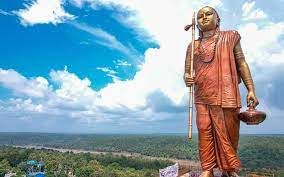
Why in News?
Recently Madhya Pradesh Chief Minister unveiled the 108-foot-tall ‘Statue of Oneness’ of Adi Shankaracharya at Omkareshwar in Madhya Pradesh.
About Adi Shankaracharya:
- Birth: 11th May 788 AD, at Kaladi, Kerala.
- Samadhi: at Kedar Tirth.
- Philosophy: Propounded the Doctrine of Advaita (Monism) and
- He was opposed to Buddhist philosophers.
- Established four Mathas in the four corners of India at Sringeri, Puri, Dwaraka and Badrinath– for propagation of Sanathana Dharma.
Major books:
- Brahmasutrabhasya (Bhashya or commentary on the Brahma Sutra), Bhajagovinda Stotra, Nirvana Shatakam and Prakaran Granths
Advocation of Advaita Vedanta:
- It articulates a philosophical position of radical nondualism, a revisionary worldview which it derives from the ancient Upanishadic texts.
- According to Advaita Vedantins, the Upanishads reveal a fundamental principle of nonduality termed ‘brahman’, which is the reality of all things.
- Advaitins understand brahman as transcending individuality and empirical plurality.
- They seek to establish that the essential core of one’s self (atman) is brahman.
- The fundamental thrust of Advaita Vedanta is that the atman is pure non-intentional consciousness.
- It is one without a second, nondual, infinite existence, and numerically identical with brahman.
Source: Indian Express
Shore Temple
Subject: Art and Culture
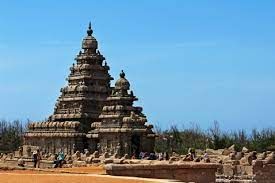
Why in News?
Tamil Nadu's Shore Temple is now India's first Green Energy Archaeological Site.
About Shore Temple:
- It is a historic temple complex located in Mamallapuram (Mahabalipuram), Tamil Nadu
- It is dedicated to Lord Shiva and Lord Vishnu.
- It was built probably in the reign of Narasimhavarman II, also known as Rajasimha (Pallava ruler) who reigned from 700 to 728 CE.
- Shore Temple is one among a number of Hindu monuments at Mahabalipuram, on the Coromandel Coast of Tamil Nadu.
- It is one of the oldest structural excellence (rock-cut) stone temples of the South India.
- The Mamallapuram monuments and temples, including the Shore Temple complex, were collectively designated a UNESCO World Heritage site in 1984.
Key facts about UNESCO
- UNESCO stands for United Nations Educational, Scientific and Cultural Organization.
- It is a specialized agency of the United Nations(UN).
- The constitution, which entered into force in 1946, called for the promotion of international collaboration in education, science, and culture.
- Headquarter: Paris, France.
- Parent Organisation - United Nations Economic and Social Council
- Goal: The primary goals of UNESCO are to contribute to peace and security by promoting collaboration among nations through education, science, and culture, and to promote sustainable development and intercultural dialogue.
Source: Times of India
The India’s Urbanization Paradox: Opportunities and Obstacles
Subject: Geography

Why in News?
According to the recent report of Ministry of Housing and Urban Affairs, about 74% of Smart City Mission projects completed, but urban challenges stay unaddressed.
About Urbanization:
- It refers to the process by which a growing proportion of a population comes to live in cities and other urban areas and the ways in which this affects society and the environment.
- It is a global phenomenon that has been driven by a variety of factors, including economic development, technological change, and population growth.
Different types of urban settlements in India:
- Census Town: Population of at least 5,000, a population density of at least 400 per sq km, where at least 75% of the male working population is engaged in non-agricultural pursuits.
- Statutory Town: A town officially designated as such by the relevant state government. These towns typically have a corporation or municipality in charge of local government.
- Satellite Town: A town that is located in close proximity to a larger urban centre and is dependent on it for economic and social activities.
- Urban Agglomeration: A continuous urban area of the city/town and also the suburban fringe/rural areas lying within the administrative boundaries of a nearby town/city.
- Suburbanization: refers to the process of urbanization where the urban areas are growing outwards, and the rural areas are becoming urbanized.
- Counter urbanization: refers to the movement of people and businesses from urban to rural areas.
Status of Urbanisation in India:
- According to the 2011 Census, India’s urbanization rate stood at 31.2%, a significant increase from 8% in 2001.
- Projections indicate that around 590 million people will reside in cities by 2030, underscoring the urgency of comprehending the growth patterns and their impact on the population.
Causes of Rapid Urbanization:
- Natural Population Growth: Urbanization is driven by the high rate of natural population increase, where cities experience a greater growth rate compared to rural areas.
- This can be attributed to improved healthcare services, better access to medical facilities, safe drinking water, and enhanced sanitation infrastructure, which contribute to higher survival rates in urban settings.
- Industrial and Agricultural Development: The substantial public investments in industries, mining, and sustainable agricultural practices have fueled urbanization.
- The growth of industries, including their associated ancillary units, contributes to the development of urban centers.
- Likewise, the expansion of business and trade, accompanied by the establishment of vibrant markets, fosters urbanization in regions closely linked to industrial and trade growth.
- Rural-Urban Migration: Rural-to-urban migration is a significant driver of rapid urbanization in India.
- The emergence of manufacturing and trade activities due to industrial development creates job opportunities and the promise of higher incomes, attracting rural residents to urban areas.
- This migration is often motivated by the prospects of employment and economic advancement.
- Push and Pull Factors: Rural-to-urban migration is influenced by both pull and push factors.
- Pull factors include the allure of urban opportunities, while push factors encompass economic constraints, lack of essential facilities, and even political unrest in rural areas, prompting individuals to seek better prospects in urban settings.
Consequences of Rapid Urbanization:
Positive Aspects:
- Driver of rapid economic growth: Rapid industrialization leads to the establishment of numerous industrial cities.
- These urban areas witness the growth of manufacturing units, ancillary industries, and the service sector, contributing to economic development.
- Increased employment opportunities: Urbanization creates new job opportunities in expanding sectors like manufacturing and services.
- This results in rural-urban migration as people seek employment in these urban centers, further promoting industrialization and urbanization.
- Modernization and attitudinal changes: Urbanization brings about changes in the mindset and behaviors of urban residents, fostering modernization and a progressive outlook.
- This shift indirectly contributes to accelerated economic development.
Negative Aspects:
- Congestion: Rapid urbanization leads to increased congestion in urban areas, causing problems such as traffic jams and high population density.
- Managing these issues becomes challenging and costly.
- Poor Quality of Life: The surge in urban population can result in various urban problems, including housing shortages, inadequate access to education and healthcare, the growth of slums, unemployment, violence, and overcrowding.
- These factors collectively lead to a decline in the overall quality of life in urban areas.
- Loss of Rural Productivity: Large-scale rural-to-urban migration diminishes productivity in rural regions.
- This trend negatively impacts the rural economy, contributing to unfavourable conditions in villages.
- Over time, excessive urbanization can have detrimental consequences.
Issues associated with Urbanization:
- Population Pressure: Rapid rural-to-urban migration leads to an overwhelming increase in urban population, straining existing public infrastructure.
- This surge in population contributes to challenges like slums, crime, unemployment, urban poverty, pollution, congestion, and public health problems.
- Proliferation of Slums: Across the country, there are approximately 13.7 million slum households, accommodating about 65.49 million people.
- Approximately 65% of Indian cities have adjacent slums where people live in cramped and substandard housing conditions.
- Housing Shortages: One of the most distressing issues associated with urbanization is inadequate housing.
- In India, more than half of urban households live in single rooms, with an average of 4.4 persons per room.
- Unplanned development: Urbanization often leads to unplanned development, exacerbating the socio-economic divide between the affluent and the underprivileged.
- The lack of proper planning perpetuates inequality within urban areas.
- Pandemic-Induced problems: The COVID-19 pandemic has exacerbated the challenges faced by the urban poor and slum dwellers. Lockdown measures severely affected their livelihoods, highlighting their vulnerability.
Government initiatives related to urban development in India:
- Deendayal Antyodaya Yojana – National Urban Livelihoods Mission (DAY-NULM): Aims to reduce poverty and vulnerability of urban poor households by providing them with opportunities for skill development and self-employment.
- Heritage City Development and Augmentation Yojana (HRIDAY): Aims to conserve and revitalize the cultural heritage and tourism potential of 12 identified cities in India.
- Swachh Bharat Abhiyan: Aims to improve sanitation and cleanliness in urban areas, including the construction of toilets and solid waste management.
- Pradhan Mantri Awas Yojana (PMAY): Aims to provide affordable housing to urban residents, particularly for low-income groups and economically weaker sections.
- Smart Cities Mission: Aims to promote the development of 100 smart cities in India, focusing on sustainable and inclusive urban development.
- Atal Mission for Rejuvenation and Urban Transformation (AMRUT): Aims to improve basic services and infrastructure in urban areas, including water supply and sewerage systems.
- Aspirational District Programme: Aims to transform the overall development landscape in 112 of India’s most backward districts. It includes urban development components and seeks to improve various aspects of life in these districts, including urban areas.
Source: The Hindu
GS-II
The Mediation Act, 2023
Subject: Governance

Why in News?
Recently, the Parliament has passed the Mediation Bill 2023.
About Mediation:
- Mediation is a voluntary process in which parties try to settle disputes with the assistance of an independent third person (the mediator).
- A mediator does not impose a solution on the parties but creates a conducive environment in which they can resolve their dispute.
- The mediation process depends on the choice of parties, and there are no strict or binding rules of procedure.
Types of Mediation:
Court Referred Mediation:
- Salem Advocate Bar Association, Tamil Nadu v. Union of India: In the case, Supreme Court held in reference to the matter of mediation that conciliation and arbitration are mandatory for court matters.
- This judgment has granted legal and social recognition to mediation as a dispute resolution in India.
Private Mediation :
- In private mediation, a qualified mediator is appointed by the parties on a fixed-fee basis. Both the parties come together to resolve the issue amicably.
- The decision of the mediator is not ultimate and hence not binding on the parties.
Key Features of the Bill
- Pre-litigation mediation: Parties must attempt to settle civil or commercial disputes by mediation before approaching any court or certain tribunals.
- Even if they fail to reach a settlement through pre-litigation mediation, the court or tribunal may at any stage refer the parties to mediation if they request for the same.
- Disputes not fit for mediation: The Bill contains a list of disputes which are not fit for mediation.
- These include disputes relating to claims against minors or persons of unsound mind, involving criminal prosecution, and affecting the rights of third parties. The central government may amend this list.
- Applicability: The Bill will apply to mediations conducted in India:
- involving only domestic parties
- involving at least one foreign party and relating to a commercial dispute (i.e., international mediation)
- if the mediation agreement states that mediation will be as per this Bill.
- If the central or state government is a party, the Bill will apply to commercial disputes, and other disputes as notified.
- Mediation process: Mediation proceedings will be confidential, and must be completed within 180 days (may be extended by 180 days by the parties).
- A party may withdraw from mediation after two sessions.
- Court annexed mediation must be conducted as per the rules framed by the Supreme Court or High Courts.
- Mediators: Mediators may be appointed by the parties by agreement, a mediation service provider (an institution administering mediation).
- They must disclose any conflict of interest that may raise doubts on their independence.
- Parties may then choose to replace the mediator.
Significance of Bill:
- India as a centre of Mediation: This legislation will help ensure that institutional mediation becomes mainstream in resolving commercial (and other) disputes between the parties, putting India on the global map as a dispute friendly jurisdiction.
- There exists a strong correlation between Ease of Doing Business (EoDB) and the promotion of mediation, and Singapore serves as a prime example of how a robust mediation ecosystem can attract greater foreign investments.
- Reduce pendency of Cases: According to the Minister for Law and Justice, there are 4.43 lakh cases pending in district subordinate courts, 60.63 lakh cases in high courts and around 70,000 cases in the Supreme Court.
- Mandating participation in pre-litigation mediation may help reduce pendency and the slow disposal rate in courts.
- Cost-effective: Mediation is a cost-effective dispute resolution process that also helps reduce the burden on courts by enabling out-of-court settlements.
- Greater Control: Mediation increases the control the parties have over the resolution.
- Each party is directly involved in negotiating their own agreement and no settlement can be imposed upon.
- Confidential: Unlike the potential publicity of court proceedings, everything said at the mediation is entirely confidential to the parties (unless specifically agreed otherwise).
- Faster outcomes: Because mediation can be used early in a dispute, an agreement can usually be reached quicker than if pursued through the courts.
Challenges of Mediation in India:
- Absence of Uniform Legislation: In 2020, the Supreme Court highlighted the pressing need for a unified mediation legislation in India, emphasizing the lack of a standardized legal framework for mediation.
- Infrastructural and Quality Control Issues: An increased focus on mediation can strain existing mediation centers, which may lack the necessary administrative capacity to handle higher caseloads efficiently.
- Societal Stigma: Concerns about public perception sometimes deter parties from choosing mediation, as they fear it might be viewed as a sign of weakness or compromise.
- Resistance from Legal Professionals: Traditional legal practitioners may exhibit resistance to adopting mediation, viewing it as a potential threat to their practice or income.
- Institutional Support: While legislative reforms have been made to promote mediation in India, the infrastructure for supporting mediation at the grassroots level, including the establishment of mediation centers and training programs, is still in the developmental stage.
- Lack of Mediation Education: The absence of mediation education within law school curricula poses a significant obstacle to the widespread adoption of mediation as a dispute resolution method.
- Shortage of Professional Mediators: India currently has a limited pool of trained and experienced mediators, which presents challenges in offering mediation services across all regions and for various types of disputes.
Way Forward: Suggestive measures
- Legal Reforms: Continuously updating laws and regulations to support and encourage mediation, while also ensuring the enforceability of mediated settlements, is crucial.
- Online Mediation: Leveraging technology for online mediation platforms can make the process more accessible, especially for those in remote areas, and provide a convenient alternative to in-person sessions.
- Institutional Support: Establishing well-equipped and accessible mediation centers at various levels, from local communities to national levels, can provide people with convenient access to mediation services.
- More Opening of Mediation and Arbitration Centre: Government should facilitate opening of mediation centers.
- Recently, Uttar Pradesh got its first mediation and arbitration centre in the form of ‘Centre for Excellence in Mediation and Arbitration or CEMA.
- Training and Certification: Developing comprehensive training programs for mediators, lawyers, and judges can ensure that there is a pool of skilled professionals proficient in mediation techniques, ethical considerations, and cultural sensitivity.
- Integration with Legal Curriculum: Incorporating mediation education within law school curricula can prepare future legal professionals to consider mediation as a primary or complementary method for dispute resolution.
Source: The Hindu
Types of Majorities in Parliament
Subject: Governance
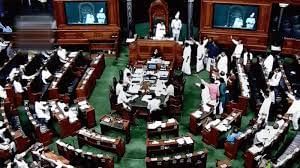
Why in News?
The Parliament passed the women’s reservation bill with a near-unanimous 2/3rd Majority Votes.
- Rajya Sabha gave the green light in an absolute majority vote.
- In Lok Sabha, 454 members voted in favour of the bill that seeks to reserve one-third of seats to women in central and state legislatures.
Types of Majority Votes
| Description | Examples of Use | |
| Absolute Majority | More than 50% of the total membership of the house. | Formation of government at the Center and States. |
| Effective Majority | More than 50% of the effective strength of the house (total strength minus vacancies). | Removal of Vice-president in RS, Speaker/Deputy Speaker removal. |
| Simple Majority | More than 50% of the members present and voting. | Passing Ordinary/Money/Financial bills, Confidence Motion, etc. |
| Special Majority | All majorities other than absolute, effective, or simple majority. | Constitutional amendment bills, National emergency approval, etc. |
Types of Special Majority: | ||
| Article 249 | 2/3rd members present and voting. | Empowering Parliament to make laws in the state list. |
| Article 368 | 2/3rd members present and voting + more than 50% of the total strength of the house. | Constitutional amendment bills not affecting federalism. |
| Article 368 + State Ratification | 2/3rd members present and voting + more than 50% of state legislatures by a simple majority. | Constitutional amendment bills affecting federalism. |
| Article 61 | 2/3rd members of the total strength of the house. | Impeachment of the Indian President. |
Source: Indian Express
GS-III
State of Working India Report 2023
Subject: Economy
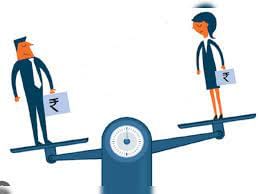
Why in News?
Recently the ‘State of Working India 2023’ report, released by Azim Premji University’s Centre for Sustainable Employment.
Major Findings of the ‘State of Working India 2023’ Report:
- Faster structural change: Between 2004 and 2017, around 3 million regular wage jobs were created annually.
- Between 2017 and 2019 this jumped to 5 million per year.
- Since 2019, the pace of regular wage job creation has decreased due to the growth slowdown and the pandemic.
- Upward mobility has increased: In 2004 over 80% of sons of casual wage workers were themselves in casual employment.
- This was the case for both SC/ST workers and other castes.
- For non-SC/ST castes, this fell from 83% to 53% by 2018 and incidence of better quality work such as regular salaried jobs increased.
- It fell for SC/ST castes as well, but to a lesser extent (86% to 76%).
- Caste-based segregation has reduced: Between 1983 and 2021, the proportion of regular wage workers belonging to the SC category has increased.
- In 2021, 32% of general caste workers were in regular wage employment as compared to 22% of SC workers.
- The report also looks at firm ownership data to conclude that general castes are over-represented to a greater degree in larger enterprises.
- Gender-based earnings disparities have reduced: In 2004, salaried women workers earned 70% of what men earned.
- By 2017 the gap had reduced and women earned 76% of what men did. Since then, the gap has remained constant till 2021-22.
- Women in job: Between 1983 and 2021, the degree of women’s representation in industries like tobacco, education, health and social work, and textiles has increased whereas in waste management and sewerage, it has decreased.
- Still, in all these sectors, women are over-represented in comparison to men.
- Unemployment is falling but remains high: Post-Covid the unemployment rate is lower than it was pre-Covid, for all education levels.
- But it remains above 15% for graduates and more worryingly it touches a huge 42% for graduates under 25 years.
- The connection between growth and good jobs remains weak: Since the 1990s year-on-year non-farm GDP growth and non-farm employment growth are uncorrelated with each other suggesting that policies promoting faster growth need not promote faster job creation.
- However, between 2004 and 2019, on average growth translated to decent employment.
- Male Breadwinner Norm: Due to the “male breadwinner” norm, as the husband’s income increases the probability of the wife being employed also reduces.
- In rural areas, the fall in probability slows down as the husband’s income increases.
Source: Indian Express
Polycystic Ovary Syndrome
Subject: Science and Technology
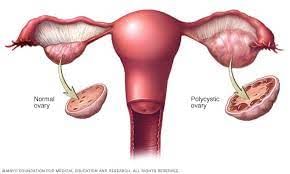
Why in News?
Key points:PCOS: hidden toll of academic pressure on health among young girls.
- One in five women in India grapples with PCOS, with 60% of those seeking infertility treatments doing so due to PCOS-related problems.
About Polycystic Ovary Syndrome:
- It is a very common hormone problem for women of childbearing age.
- Symptoms:
- Women with PCOS may not ovulate, have high levels of androgens, and have many small cysts on the ovaries.
- It can cause missed or irregular menstrual periods, excess hair growth, acne, infertility, and weight gain.
- Causes: Genetic predisposition, often marked by a family history of diabetes or obesity, exposed to environments that encourage neither a healthy diet nor regular exercise and are stress-laden.
- Treatment: It can be prevented through lifestyle changes, medications and fertility treatments.
Source: The Hindu
|
38 videos|5283 docs|1116 tests
|
















